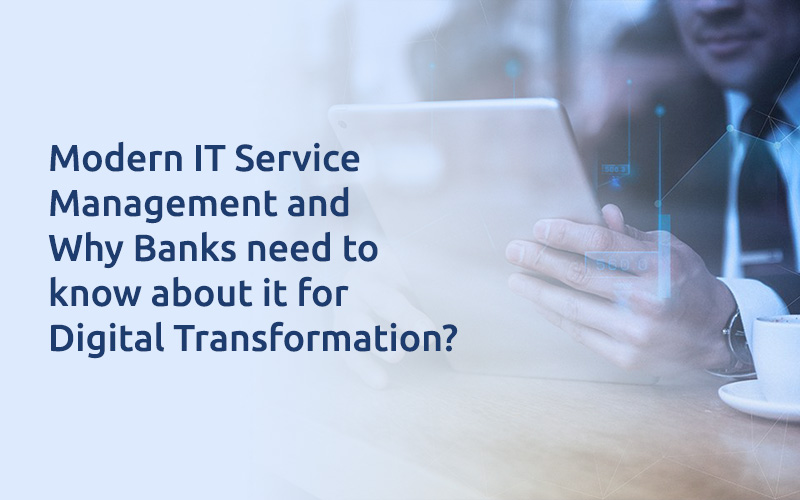
Modern IT Service Management and Why Banks need to know about it for Digital Transformation?
ServiceNow and other ITSM solutions have progressed beyond issue ticketing systems to entire workflow management frameworks.
For banks, digital transformation is currently a primary priority: According to a recent poll, 32% of financial businesses are focusing on better change management, while 36% are focusing on simplifying or upgrading old IT.
Banks can accomplish both using modern IT service management (ITSM) systems like ServiceNow, which completely automate workflow and services in a cloud-based environment. This paradigm is a far cry from many financial institutions’ conventional trouble ticket systems, and it necessitates an implementation strategy that acknowledges the new effect of ITSM, prioritizes its transformational benefits and pinpoints where new solutions may most benefit banking services.
Modern IT Service Management and ServiceNow
The first ITSM implementations were focused on narrow-stream solutions that were meant to achieve specific, small-scale goals. Customers experiencing problems with web-based login portals or employees having problems with internal platform authentication are examples of this. The process was straightforward: tickets were created, support workers were alerted, and solutions were discovered.
The system was also effective — so effective, in fact, that ticket-type ITSM now underlies nearly every financial firm’s service and solution.
ITSM, on the other hand, has evolved in tandem with technology such as cloud computing, mobile connection, and data analytics. Modern ITSM functions as an operation central nervous system capable of managing all parts of an IT environment with centralized process visibility, data transparency, and user experience models, rather than operating a slew of fragmented processes, each with its own service aim.
ITSM has grown from customized and IT-centric answers to inclusive and enterprise-focused service solutions capable of managing and automating workflows at scale, much how Amazon extended its platform and capabilities, ranging from disrupting book sales to transforming e-commerce widely.
Know about ServiceNow ITSM and how it has evolved with requirements of digital transformation (link: https://www.dxsherpa.com/digital-transformation-aitsm-in-a-post-pandemic-world-with-servicenow-2/)
Digital Transformation Empowered: ServiceNow
Companies may use the industry-leading ITSM platform to help them deliver on digital transformation projects at three key stages:
Standardization: ITSM objectives for many banks are focused on performing the same things they’ve always done, but quicker. ServiceNow can assist businesses in identifying the critical frameworks and functions they need to develop, as well as designing and deploying systems that help standardize service operations and reduce point solutions.
Modernization: With proactive and predictive procedures meant to automate workflows, decrease error rates, and optimize cycle times, the correct ITSM implementation may also help modernise the digital experience and break through old silos.
Innovation: ServiceNow offers a level of services unmatched by customer relationship management or enterprise resource planning solutions, allowing businesses to innovate in areas like data trend mapping, AI integration, and intelligent authentication thanks to its connection to IT services and data sources across the organization.
Digital transformation through ITSM for Banks
Security Operations: Financial organizations confront a more difficult security issue than their mainstream industry counterparts, with a mix of contemporary, customer-facing software and antiquated systems built on code such as COBOL. Advanced ITSM solutions may aid in the mapping of essential security dependencies, the identification of possible vulnerabilities and gaps, and the identification of preventative measures.
Merger and Acquisition Enhancements: Banks are also under constant pressure from mergers and acquisitions. While linking different technologies is one component of an M&A exercise, building a shared operational culture is frequently what determines the success of the transaction. Modern ITSM aids in the formation of a shared corporate perspective and the facilitation of a unified IT function.
User experience improvement: Speaking of IT function, many banks still struggle with end-user experience. Modernizing ITSM and broadening the perspective to encompass enterprise service management processes allows for the creation of both internal and external experiences that minimize complexity and provide individualized process interactions for both employees and clients.
Although ITSM is still an important part of banking operations, the fragmented structure of conventional issue ticket systems might conflict with digital transformation goals. Banks may benefit from modern ITSM installations that consolidate and standardize important operations to meet the rising demand of automated, integrated IT service management at scale.
